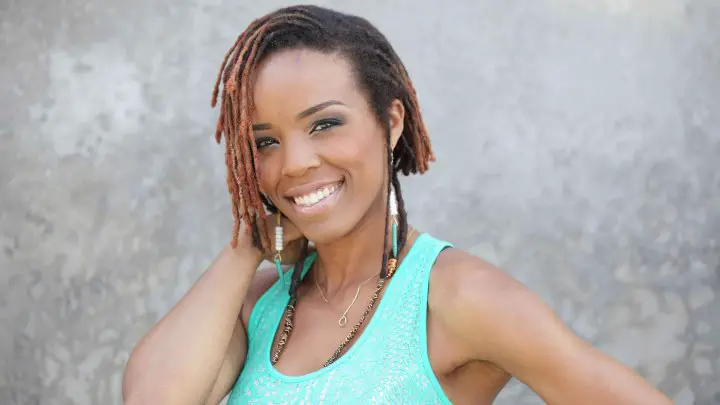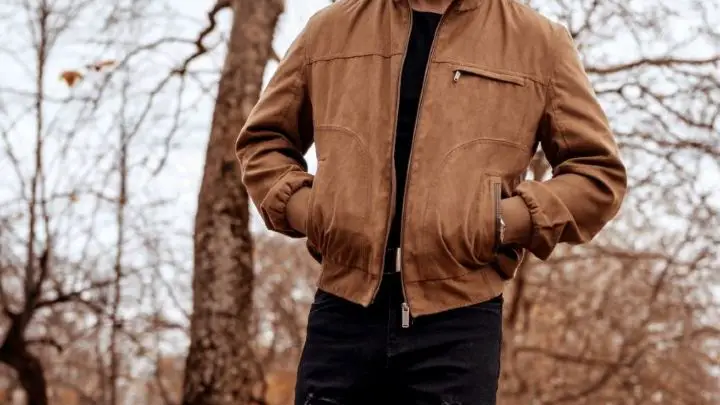Gone are the days when dreadlocks belonged to just a sect. Recent fashion has seen a lot of people switch to dreads and this is because of their flexibility; dreads allow you wear almost any hairstyle on the dread. So, if you’re looking to dread your afro and enjoy this flexibility, welcome on board.
Although there are faux locs hairstyles to give you the feel of dreadlocks having the real locs could be a golden feeling. More so, faux locs extensions could be quite bulky. Turning your afro into dreadlocks allows you to go through the growth process and love your hair the more.
So, if you’ve been searching for a guide to help you dread your afro, your search is over. This article has everything you need to know about the journey into the dreadlocks tribe.
1. Dread Your Afro With a Sponge Brush
- This method uses a curl sponge to dread short afro hair of about two inches
- You should be working with a clean scalp and hair. So, wash your hair and scalp clean with sulfate-free shampoo and conditioner to remove oil and dirt
- Use a microfiber towel or an old tee to remove excess water before you start
- Work with small sections of hair at a time
- Brush a small section of your hair in repeated circular motions until the hair there is balled up
- Thereafter, move to another section of your hair and brush the hair into balls
- Then, apply dread cream or dread wax to each ball formed. This cream or wax will help to give the hair more hold and keep them moisturized
- Secure each ball of hair at the roots with an elastic band
- Afterward, dry your new dreads with a hairdryer. Make sure you’re using the dryer in a cool setting
- Also, the heat from the dryer will help to melt the wax into each lock and aid the locking process
- After drying your locs, leave them to sit for up to three hours. During this period, try not to lay on your dreads or touch them. Otherwise, they’d unravel
2. Dread Your Afro With a Crochet Hook
- Crocheting your hair into dreads is a good way to get dreads with blunt ends
- The crochet hook size should be within the range of US size 0-000 (2.0-1.5mm)
- Wash your hair to remove oil and dirt residue
- Afterward, divide your hair into medium-sized sections to make crocheting easy
- Work with one section at a time. Loosen a section and comb it well to remove knots
- Thereafter, take a small section (according to how thick or thin you want your dreads to be) and begin to backcomb from the end to the root
- Backcombing will add texture to the hair and make it look fluffy
- Then, take your crochet hook, pick up a few hairs on one side and pull them through the section of hair to the other side. Start from the scalp and work up to the ends
- You’ll notice that section of hair is gradually turning into dread and there is no stray hair on the edges of the new dread
- Afterward, push the crochet hook again into the dread but this time, it should be halfway up the dread
- Gently pull it back but not out of the dread. Repeat this a few more times until the dread feels tighter
- Repeat the above steps all over your hair until your whole head is covered with dreads
- Now, to get the ends of your dreads blunt, hold out the end of the new dreads and push in the crochet hook such that it comes out at the end
- Use the hook to grasp a few of the hairs at the end and quickly pull them back
- Repeat this without removing the hook until you have dreads with blunt ends
- Finally, dry your hair to remove moisture and leave them to sit for up to three hours
3. Dread Your Afro by Comb Twisting
- Comb twisting method is a good option for people with coarse, short hair of about 2 inches
- Start with washing your hair with sulfate-free shampoo and conditioner
- Remove excess water with a microfiber towel and leave your hair moist
- Divide the hair into small sections and comb each well to remove knots
- Then, apply dreadlock cream to each section of hair and secure them with an elastic band
- One section after the other, insert a rattail comb into your hair and begin to twist from the root up to the end
- When twisting, make sure the hair remains at the teeth of the comb
- By the time you’re done twisting, the hair should be already twisted into a dread
- Do this all over your hair until you have covered all sections
- Thereafter, dry your hair with a hairdryer in a cool setting
- When the locs are dry, leave them to sit for about three hours. Make sure you keep your hands off the new dreads. Also, do not lay down either
SEE: Trendy Ways to Style Dreadlocks
Stages of Dreads Formation on Afro Hair
1. The starter stage
The starter stage is the first 3-6 months of turning your afro into dreads. This is the period where your hair coils and it is characterized by clean sections and small-sized dreads. During these months, you shouldn’t shampoo your hair for the first two weeks.
When you begin to wash them, make sure you’re using shampoo and conditioner that are safe for locs and won’t leave residues. Keep the baby locs moisturized; invest in conditioners. Also, let the new locs follow their growth path.
2. The budding stage
The stage after baby locs is when your dreads look puffier because they now intertwine rapidly and become thicker. At this stage, you should have an established wash routine to avoid getting buildups and weak spots.
This stage lasts 6-12 months and is accompanied by fading parts (which is not a problem). In addition, re-twist your dreads occasionally but not too frequently to prevent breakage.
3. The teen stage
For 12-15 months after the budding stage, your dreadlocks go into the teen stage. They are past the tension that can unravel them; you can as well think of this as the stage where you dreads fully lock. Your dreadlocks grow bigger and may sometimes look stunted in length.
At this stage, your locs need maintenance. You shouldn’t hop on every product because they are highly prone to build-up at the stage. You can begin to invest in hair accessories like scarves so you can manipulate them into different styles.
4. The maturity stage
When you notice that your locs are firmer and closed at the ends, they’re in their maturity stage. In this stage of dread formation, you don’t need too frequently because they are becoming adults and they can also fall to the back of your head to take any form you style them into.
This stage takes 15-18 months. Additionally, make sure you keep up with your wash routine and use products that won’t leave product build-up on your scalp. Also, condition the locs daily to keep them moisturized.
5. The rooted stage
At this point, your locs are full-grown adult dreadlocks. From 18 months onward, your dreads will feel heavier and more defined. You can let them grow to any length you want. At this stage, your locs need frequent trims to keep breakage and deterioration at bay.
Additionally, you can start deep conditioning your dreadlocks every two weeks. Because they are now thicker, you should dry them properly after washing to prevent molds from forming. Also, adult dreads are prone to frizz, so you should always keep them wrapped in silk at night.
How to Make Dreads Lock Faster
1. Re-twist your dreads
Although you shouldn’t be doing this too often, re-twisting your dreads can help lock them faster. This is good for dreads between the starter and teen stage (that is during the first 15 months of getting dreads). Use a crochet hook to pull in stray hairs and tighten the dreads.
You can start at a frequency of once a week to two to three times a month. However, this re-twisting should not start until after the first 2 to 3 weeks. You can also re-twist with your finger in a clockwise direction to help the dreads lock faster.
2. Palm roll each dread
Make palm rolling your dreads a daily routine to get your dreads to lock faster. Hold each dread between your palms and roll from the ends to the root. Roll rapidly to smoothen each dread. Repeat this on each dread.
Reaching the dreads on the back can be quite difficult for you. To palm roll the dreads on the back, you can ask someone to help you palm roll them.
How to Care for Your Dread
Have an established dread care routine
Create a routine that works for your dreadlocks. You can do this with the help of a loctician. Wash your dreadlocks once or twice a week to keep your scalp and hair clean and free from oil and product build-up.
You also shouldn’t wash your locs too much, especially when they are still between the baby and budding stage of formation. During these months, they are easily unraveled by washing. Remember that washing hair too frequently can leave it drier; the same applies to dreadlocks.
SEE: Can You Wash Dreadlocks? See How to Care For Your Locs
Be generous with moisture
Dreads need moisture. Invest in moisturizing products like moisturizing hair oils and sprays. Also, make a routine of deep conditioning your dreadlocks every two weeks to boost moisture levels. Leaving locs dry will expose them to frizz, split ends, and breakage.
Don’t overdo hair products
Avoid burdening your locs with products like wax and gel. While these products can help keep your locs smooth, they can also leave them greasy with build-up. Do not use them every day and when you do, use products formulated for dreads.
SEE: Best Conditioner Products To Boost Your Hair Growth
Get trims
Trim mature dreads every 4-6 months to avoid deterioration. Dreads are still your hair and are also prone to split ends and breakage. Trimming them will intercept this process and keep excessive breakage at bay.
Wrap your locs with silk at night
Early locs are prone to unraveling and mature locs are prone to frizz. Always protect your dreadlocks with a silk headscarf or bonnet before you sleep. Wrapping your locs this way will protect them from friction and frizz.
FAQs
How long does it take for dreads to lock?
How long it takes for dreads to lock depends on your hair type, hair texture, and maintenance. Generally, it takes between 10-24 months for dreads to lock fully. The above-mentioned factors determine how fast your dreads will lock.
Can twists turn to dreads?
Yes, they can. You can start natural dreads on twists just like you can with braids. Two-strand twists take between 8-18 months to lock. During this period, the roots first begin to lock, and then, your natural hair loosens and locs too.
Can afro hair become dreads naturally?
One of the natural ways to get dreads on your afro hair is to stop combing and brushing it over a long period. However, you must not stop washing and caring for your hair, otherwise, your hair will become a breeding ground for microorganisms.
Conclusion
Turning your afro into dread could be quite tasking and time-consuming but eventually, it’s worth the effort. There are different ways to dread an afro. The method you choose to go with depends on what you’re looking to achieve, your hair texture, and density.
Whichever method you go with, keep track of your dread’s growth stages, care for them properly, and always seek expert knowledge when you’re lost.
Thanks for reading.
If you need to get accurate information on anything hair, including dreads, Africana Fashion is the place to look.







